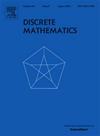Bipartite friends and strangers walking on bipartite graphs
IF 0.7
3区 数学
Q2 MATHEMATICS
引用次数: 0
Abstract
Given n-vertex simple graphs X and Y, the friends-and-strangers graph has as its vertices all n! bijections from to , where two bijections are adjacent if and only if they differ on two adjacent elements of whose mappings are adjacent in Y. We consider the setting where X and Y are both edge-subgraphs of : due to a parity obstruction, is always disconnected in this setting. Modestly improving a result of Bangachev, we show that if X and Y respectively have minimum degrees and and they satisfy , then has exactly two connected components. This proves that the cutoff for to avoid isolated vertices is equal to the cutoff for to have exactly two connected components. We also consider a probabilistic setup in which we fix Y to be , but randomly generate X by including each edge in independently with probability p. Invoking a result of Zhu, we exhibit a phase transition phenomenon with threshold function . More precisely, below the threshold, has more than two connected components with high probability, while above the threshold, has exactly two connected components with high probability. Altogether, our results settle a conjecture and completely answer two problems of Alon, Defant, and Kravitz.
在二部图上行走的二部朋友和陌生人
给定n个顶点的简单图X和Y,朋友-陌生人图FS(X,Y)的顶点都是n!从V(X)到V(Y)的双射,其中两个双射相邻当且仅当它们在V(X)的两个相邻元素上不同,而V(X)的映射在Y上相邻。我们考虑X和Y都是Kr,r的边子图的情况:由于宇称阻碍,FS(X,Y)在这种情况下总是断开的。适度改进了Bangachev的结果,证明如果X和Y分别具有最小度δ(X)和δ(Y),且满足δ(X)+δ(Y)≥⌊3r/2⌋+1,则FS(X,Y)恰好有两个连通分量。这证明了FS(X,Y)避免孤立顶点的截止点等于FS(X,Y)恰好有两个连通分量的截止点。我们还考虑了一个概率设置,其中我们将Y固定为Kr,r,但通过以概率p独立地包括Kr,r中的每条边来随机生成X。调用Zhu的结果,我们展示了具有阈值函数(log (r))/r的相变现象。更准确地说,在阈值以下,FS(X,Kr,r)有两个以上的高概率连通分量,而在阈值以上,FS(X,Kr,r)正好有两个高概率连通分量。总之,我们的结果解决了一个猜想,并完全回答了Alon, Defant和Kravitz的两个问题。
本文章由计算机程序翻译,如有差异,请以英文原文为准。
求助全文
约1分钟内获得全文
求助全文
来源期刊

Discrete Mathematics
数学-数学
CiteScore
1.50
自引率
12.50%
发文量
424
审稿时长
6 months
期刊介绍:
Discrete Mathematics provides a common forum for significant research in many areas of discrete mathematics and combinatorics. Among the fields covered by Discrete Mathematics are graph and hypergraph theory, enumeration, coding theory, block designs, the combinatorics of partially ordered sets, extremal set theory, matroid theory, algebraic combinatorics, discrete geometry, matrices, and discrete probability theory.
Items in the journal include research articles (Contributions or Notes, depending on length) and survey/expository articles (Perspectives). Efforts are made to process the submission of Notes (short articles) quickly. The Perspectives section features expository articles accessible to a broad audience that cast new light or present unifying points of view on well-known or insufficiently-known topics.
 求助内容:
求助内容: 应助结果提醒方式:
应助结果提醒方式:


